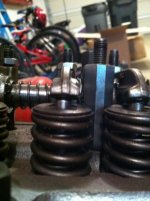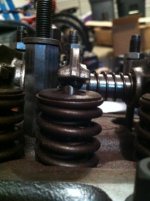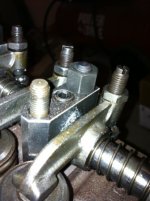64rocksprite
Jedi Trainee
Offline
Well, I'm stuck until you all can help me out with this one.
I installed 1.5 rockers from MiniSpares, which came with specific taller pedestals.
I've tried to get the rocker pads centered, but you can see I have a few that are a bit off center, but are up against the pedestal, so it's not a shim (or remove shim) question.
So..I would think ideally these need to be centered, but are these off enough that I need to take off some material..or ??
Final related question:
The new rocker shaft has a set screw that the old pedestal washer/tab won't fit over as it sits proud of the top of the pedestal. Do I need these tabs? or can I substitute a washer? Or should I grind this set screw down flush? I guess its not obvious to me why we need a tab on top of a solid block of steel?
Appreciate your input.
PS: I think I need to get Drew's set-up where he had an old laptop in the garage..cleaning up so I can come inside and type this is costing me valuable shop time! :hammer:
I installed 1.5 rockers from MiniSpares, which came with specific taller pedestals.
I've tried to get the rocker pads centered, but you can see I have a few that are a bit off center, but are up against the pedestal, so it's not a shim (or remove shim) question.
So..I would think ideally these need to be centered, but are these off enough that I need to take off some material..or ??
Final related question:
The new rocker shaft has a set screw that the old pedestal washer/tab won't fit over as it sits proud of the top of the pedestal. Do I need these tabs? or can I substitute a washer? Or should I grind this set screw down flush? I guess its not obvious to me why we need a tab on top of a solid block of steel?
Appreciate your input.
PS: I think I need to get Drew's set-up where he had an old laptop in the garage..cleaning up so I can come inside and type this is costing me valuable shop time! :hammer:

 Hi Guest!
Hi Guest!

 smilie in place of the real @
smilie in place of the real @
 Pretty Please - add it to our Events forum(s) and add to the calendar! >>
Pretty Please - add it to our Events forum(s) and add to the calendar! >> 




